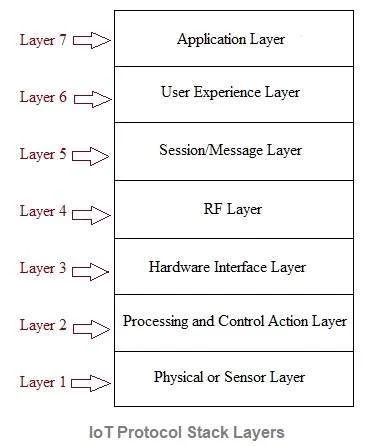IoT Protocol Stack Layers | IoT Stack Layer 1 to Layer 7
This page on IoT Protocol Stack Layers describes functions of IoT Stack Layer 1, Layer 2, Layer 3, Layer 4, Layer 5, Layer 6 and IoT Layer 7.
Lile other wired and wireless technologies, IoT (Internet of Things) also has protocol layers from layer 1 to 7. We have seen OSI (Open System Interconnection) model which defines 7 layer networking framework. OSI defines functions of each of these layers and their interfaces.
Let us understand functional description of 7 layers of IoT protocol stack as shown in the figure below.

IoT stack consists of following seven layers viz. Sensor layer, processing/control layer, hardware interface layer, RF layer, session/message layer, user experience layer and application layer.
IoT Stack Layer 1
Physical or sensor layer:
Similar to OSI physical layer, this IoT layer 1 interfaces with physical components.
The physical components are mainly sensors such as humidity sensor, temperature sensor, pressure sensor,
heartrate sensor, pH sensor, odour sensor etc. The sensors are used for sensing of various parameters as per application of use.
There are plenty of sensors available for same functionality and hence appropriate selection of sensor
is done based on cost and quality. It is this layer-1 which provides sensed data to IoT stack for further processing.
IoT Stack Layer 2
Processing and control layer :
The data provided by layer-1 using sensors are processed at this layer.
Microcontroller/Processor and operating system play vital role at this layer.
Various development kits can be used for this purpose such as Arduino, NodeMCU (based on ESP32 or ESP8266) ,
ARM, PIC etc. Typical operating systems used are Android, Linux, IOS etc.
IoT Stack Layer 3
Hardware Interface layer :
This layer include components or interfaces used for communication such as RS232, RS485, SPI, I2C, CAN, SCI etc.
These interfaces are used for serial or parallel communication at various baud rates in synchronous/asynchronous modes.
The above mentioned interface protocols ensure flawless communication.
IoT Stack Layer 4
RF layer :
This radio frequency layer houses RF technologies based on short range or long range and data rate desired by
the application of use. The common indoor RF/wireless technologies include Wifi, Bluetooth, Zigbee, Zwave, NFC, RFID etc.
The common outdoor RF cellular technologies include GSM/GPRS, CDMA, LTE-M, NB-IoT, 5G etc.
RF layer does communication of data using radio frequency based EM waves.
There is another technology which uses light waves for data communication.
This light based data communication is referred as LiFi.
IoT Stack Layer 5
Session/Message Layer :
This layer deals with various messaging protocols such as MQTT, CoAP, HTTP, FTP (or Secured FTP), SSH etc.
It defines how messages are broadcasted to the cloud. Refer architectures of
MQTT protocol and CoAP protocol.
IoT Stack Layer 6
User experience layer :
This layer deals with providing best experience to the end users of IoT products.
To fulfill this, this layer takes care of rich UI designs with lots of features.
Various languages and tools are developed for the design of GUI interface softwares.
These include objected oriented and procedure oriented technologies as well database languages (DBMS, SQL) in addition to
analytics tools.
IoT Stack Layer 7
Application layer :
This layer utilizes rest of the six layers in order to develop desired application.
The typical case studies or applications of IoT are as follows.
• Smart Home
• Smart Parking System based on zigbee,
LoRaWAN and other wireless technologies.
• Smart Energy System, Refer Smart Grid Architecture.
• Smart City
• Smart lighting system based on zigbee standard
• Smart Retail
• Smart Agriculture farming
• Smart Waste Management
Conclusion:
Based on IoT application, appropriate layers and protocols/technologies are used at the 7 layers described
above in an IoT protocol stack. Refer IoT stack vs Web stack >> for difference between IoT stack and Web stack.
